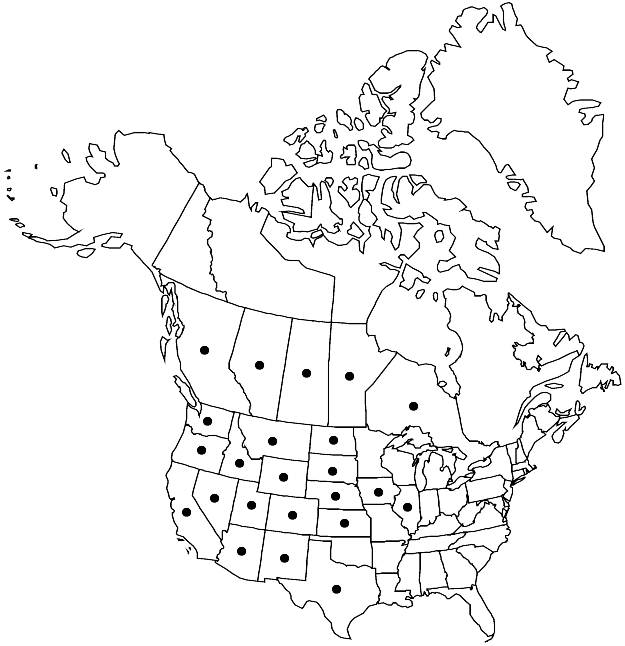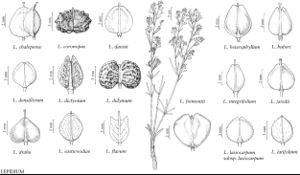Lepidium chalepense
Cent. Pl. II, 23. 1756.
Perennials; (rhizomatous); densely hirsute to glabrate or glabrous. Stems several from base, erect or decumbent basally, branched (several) distally, (0.8–) 2.1–6.6 (–9.2) dm. Basal leaves (early withered); not rosulate; petiole 0.9–4.4 cm; blade obovate, spatulate, or ovate, (1.8–) 2.5–8.6 (–14) cm × 10–37 mm, margins subentire or dentate. Cauline leaves sessile; blade obovate to oblong or lanceolate to oblanceolate, (1.5–) 2.6–9.3 (–13.2) cm × (7–) 12–31 (–45) mm, base sagittate-amplexicaul or auriculate, margins dentate or entire, (surfaces pubescent or glabrous). Racemes (corymbose panicles), elongated in fruit; rachis glabrous or puberulent, trichomes cylindrical, straight or curved. Fruiting pedicels ascending to horizontal, straight, (terete), 5–16 (–19) × 0.2–0.3 mm, glabrous or sparsely puberulent adaxially. Flowers: sepals oblong to ovate, 1.7–3 × 1–1.6 mm; petals white, obovate, 3–5 × 1.2–2.4 mm, claw 1.2–2 mm; stamens 6; filaments 2–3.3 mm, (glabrous); anthers 0.5–0.6 mm. Fruits (indehiscent), obovoid to subglobose or obcompressed globose, 3.5–5.8 (–7) × (3.5–) 4–6.2 (–7) mm, apically not winged, apical notch absent; valves thin, smooth, often not veined, glabrous; style (0.8–) 1.2–2 (–2.3) mm. Seeds (dark reddish-brown), ovate, 1.5–2.3 × 1–1.3 mm. 2n = 48, 80, 128.
Phenology: Flowering May–Jun.
Habitat: Mountain slopes, roadsides, fields, agricultural lands, stream banks, pastures, waste areas
Elevation: 300-4200 m
Distribution

Introduced; Alta., B.C., Man., Ont., Sask., Ariz., Calif., Colo., Idaho, Ill., Iowa, Kans., Mont., Nebr., Nev., N.Mex., N.Dak., Oreg., S.Dak., Tex., Utah, Wash., Wyo., Asia, also in South America (Argentina), Europe
Discussion
From the synonymy above, it is evident that the disposition of Lepidium chalepense has varied: more than one species (e.g., R. C. Rollins 1940; G. A. Mulligan and C. Frankton 1962), one species (e.g., Rollins 1993), a variety of Lepidium (Cardaria) draba (N. H. Holmgren 2005b), or a synonym of the latter species (C. L. Hitchcock 1936). In our opinion, the differences in fruit morphology and chromosome number justify its recognition as a distinct species.
Selected References
None.
Lower Taxa
"elongated" is not a number."thick" is not a number."dm" is not declared as a valid unit of measurement for this property."dm" is not declared as a valid unit of measurement for this property.
